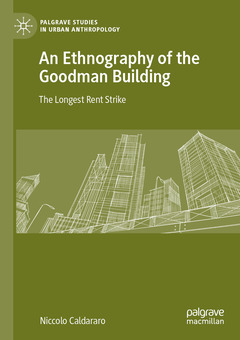Description
An Ethnography of the Goodman Building, 1st ed. 2019
The Longest Rent Strike
Palgrave Studies in Urban Anthropology Series
Author: Caldararo Niccolo
Language: English
Subjects for An Ethnography of the Goodman Building:
Approximative price 52.74 €
In Print (Delivery period: 15 days).
Add to cartPublication date: 08-2020
374 p. · 14.8x21 cm · Paperback
Publication date: 05-2019
374 p. · 14.8x21 cm · Hardback
Description
/li>Contents
/li>Biography
/li>Comment
/li>
?An Ethnography of the Goodman Building vividly incorporates a wide variety of methods to tell the story of class struggle in a building, neighborhood, and city that is replicated globally. I read it as a number of boxes inside each other opened in the course of reading. Caldararo recounts the building?s personal ?biography? to convey not only the ?facts about,? but the ?feelings about? the flesh and blood of the building and its surrounding neighborhood.? ?Jerome Krase, Brooklyn College of The City University of New York, USA
?This unique contribution to the field of urban and regional studies counteracts current trends in the ethnographies of urban movements by offering, with great hindsight, an analysis from a physical space, and from first-hand experience. The focal point is one building, and the author is a former tenant. This perspective is appealing, especially in an era of global connections where macro social movements are on the front line of urban life and research.? ?Nathalie Boucher, Director and Researcher, Respire, and Affiliated Professor Assistant, Department of Sociology and Anthropology, Concordia University, Canada.Through in-depth analysis and narrative investigation of an actual building occupation, Niccolo Caldararo seeks to not only offer an historical account of the Goodman Building in San Francisco, but also focus on the active resistance tactics of its residents from the 1960s to the 1980s. Taking as its focal point the building itself, the volume weaves in and out of every life involved and the struggles that surround it?San Francisco?s urban renewal, ethnic clearing, gentrification, and municipal governance at a time of booming urban growth. Caldararo, a tenant at the center of its strikes and activities, provides a unique perspective that counteracts current trends in ethnographies of urban movements by grounding its analysis in physical and tangible space.
Section V: A New Start in a Changing City
Chapter 15: Assessment: New Goodman Building in the Era of Go-go Capitalism.Chapter 16: Conversations at G2: The New Goodman Building Interviews with Tenants at the 18th Street Complex.
Grounds urban ethnography in a physical space, the Goodman Building
Provides the first example of a “building biography” in Urban Anthropology, a model for future study
Examines the greatly changing urban environment from the point of view of a single community



